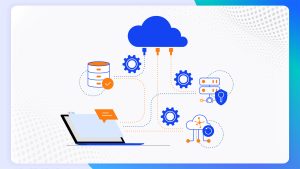
Cloud-native development and microservices architecture have become crucial for modern software development. In this article, we will explore the benefits, challenges, and best practices associated with these approaches and the tools and technologies that enable their successful implementation
Benefits of cloud-native development
Cloud-based development offers numerous advantages, including scalability, flexibility, and cost-efficiency. Developers can leverage cloud platforms to build and deploy applications that dynamically scale depending on demand, reducing infrastructure costs. Cloud-native approaches also enable faster development cycles, enhanced resilience, and improved resource utilization through containerization, allowing developers to focus on developing and delivering innovative features. This makes cloud-based development a key factor for the success of any software development project. Additionally, cloud-based development helps to reduce IT costs, improve data security, and accelerate time to market.
Microservices Architecture for Agile Development
Microservices architecture promotes modularity, enabling teams to develop and deploy independent services that work together to form a more extensive application. This approach facilitates agile development, as teams can work on different services simultaneously, enabling faster iterations and updates. Microservices architecture supports scalability, fault isolation, and easier maintenance, allowing seamless scaling and updates without affecting the entire system. This makes it easier and more efficient for teams to respond to changes in the market and user needs quickly. Additionally, it helps to reduce the complexity and cost of development.
Kubernetes for Container Orchestration
Kubernetes has emerged as a leading container orchestration platform, providing automated deployment, scaling, and management of containerized applications. It offers features like load balancing, service discovery, and self-healing capabilities, ensuring cloud-native applications’ resilience and high availability. Developers can leverage Kubernetes to simplify container deployment, scaling, and management, streamlining development and operations processes. Kubernetes is also a great tool for managing multiple distributed applications and resources, allowing for faster development cycles and easier scalability of applications. It is also highly secure and can provide end-to-end encryption of communication between containers, protecting applications and data from malicious actors.
Serverless Computing for Event-Driven Architectures
Serverless computing, or Function-as-a-Service (FaaS), enables developers to focus solely on writing code without managing infrastructure. It allows for event-driven architectures, where code executes in response to specific events or triggers. Serverless platforms like AWS Lambda and Azure Functions provide automatic scaling, reduced operational overhead, and cost optimization. This makes them ideal for building highly responsive and cost-effective cloud-native applications. Serverless computing also allows developers to quickly and easily deploy applications without worrying about managing the underlying infrastructure. This makes it an attractive option for developers looking to quickly and cost-effectively build and deploy applications.
Challenges and Best Practices
While cloud-native development and microservices architecture offer significant benefits, they also present challenges. These include managing distributed systems, ensuring service discovery, monitoring, and maintaining data consistency. Best practices involve adopting containerization, implementing a service mesh for seamless communication between services, employing observability tools, and embracing automation and continuous deployment practices. Organizations should also take into account the security implications of such architectures. This includes data security, authentication, authorization, and encryption. Finally, companies should consider investing in the necessary training and infrastructure to ensure that their teams are prepared to work with cloud-native technologies.
Conclusion
Cloud-native development and microservices architecture empower developers to build scalable, flexible, and efficient applications. By leveraging Kubernetes for container orchestration, embracing serverless computing, and following best practices, developers can unlock the full potential of cloud-native development and deliver innovative solutions in 2023 and beyond. Companies that embrace cloud-native development and microservices architecture will stay ahead of the competition and gain a competitive edge in the market. Moreover, they will be able to reduce costs and increase efficiency, helping them achieve their desired goals.
Ready to embrace cloud-native development and a microservices architecture? Leverage Kubernetes for container orchestration, explore serverless computing options and adopt best practices for scalable and resilient applications. Unlock innovation and efficiency with us on your software development journey.
Resources:
- “Cloud Native Computing Foundation” – https://www.cncf.io/
- “The Kubernetes Official Website” – https://kubernetes.io/
- “Serverless Computing with AWS Lambda” – https://aws.amazon.com/lambda/
- “Azure Functions Documentation” – https://docs.microsoft.com/azure/azure-functions/